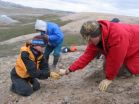(Press-News.org) If you've gone grocery shopping lately, you've probably bought palm oil.
Found in thousands of products, from peanut butter and packaged bread to shampoo and shaving cream, palm oil is a booming multibillion-dollar industry. While it isn't always clearly labeled in supermarket staples, the unintended consequences of producing this ubiquitous ingredient have been widely publicized.
The clearing of tropical forests to plant oil palm trees releases massive amounts of carbon dioxide, a greenhouse gas fueling climate change. Converting diverse forest ecosystems to these single-crop "monocultures" degrades or destroys wildlife habitat. Oil palm plantations also have been associated with dangerous and abusive conditions for laborers.
Significantly eroded water quality now joins the list of risks associated with oil palm cultivation, according to new research co-authored by researchers from Stanford University and the University of Minnesota, who warn of threats to freshwater streams that millions of people depend on for drinking water, food and livelihoods. The new study in the Journal of Geophysical Research: Biogeosciences contains surprising findings about the intensity and persistence of these impacts, even in areas fully forested with mature oil palm trees.
Land clearing, plantation management (including fertilizer and pesticide application) and processing of oil palm fruits to make crude palm oil can all send sediment, nutrients and other harmful substances into streams that run through plantations. Vegetation removal along stream banks destroys plant life that stream organisms depend on for sustenance and shade.
"Although we previously documented carbon emissions from land use conversion to oil palm, we were stunned by how these oil palm plantations profoundly alter freshwater ecosystems for decades," said study co-author and team leader Lisa M. Curran, a professor of ecological anthropology at Stanford and a senior fellow at the Stanford Woods Institute for the Environment.
Palm oil epicenter
Indonesia produces almost half of the world's palm oil. Home to the world's third-largest tropical forest, the country is also one of the principal emitters of greenhouse gases, due to the rapid conversion of carbon-rich forests and peatlands to other uses.
From 2000 to 2013, Indonesia's land used for oil palm cultivation more than tripled. About 35 percent of Indonesian Borneo's unprotected lowlands may be cleared for oil palm in coming years, according to previous research by Curran and the study's lead author, Kimberly Carlson, a former Stanford graduate student who is now a postdoctoral scholar at the University of Minnesota's Institute on the Environment.
Curran, Carlson and their colleagues focused on small streams flowing through oil palm plantations, smallholder agriculture and forests in and around Gunung Palung National Park, a federally protected area that Curran was instrumental in establishing in 1990. They found that water temperatures in streams draining recently cleared plantations were almost 4 degrees Celsius (more than 7 degrees Fahrenheit) warmer than forest streams. Sediment concentrations were up to 550 times greater. They also recorded a spike in stream metabolism – the rate at which a stream consumes oxygen and an important measure of a stream's health – during a drought.
Possible solutions
The impact of these land use changes on fisheries, coastal zones and coral reefs – potentially many miles downstream – remains unclear because this study is one of the first to examine the oil palm's effects on freshwater ecosystems. "Local communities are deeply concerned about their freshwater sources. Yet the long-term impact of oil palm plantations on freshwater streams has been completely overlooked until now," Curran said. "We hope this work will highlight these issues and bring a voice to rural communities' concerns that directly affect their livelihoods."
Potential management solutions, according to Carlson and Curran, include maintaining natural vegetative cover next to streams and designing oil palm plantations so that dense road networks do not intersect directly with waterways. These kinds of improved practices are being pioneered by the Roundtable on Sustainable Palm Oil and other organizations that certify palm oil production as sustainable. Yet, Carlson said, "Our findings suggest that converting logged forests and diverse smallholder agricultural lands to oil palm plantations may be almost as harmful to stream ecosystems as clearing intact forests." Very few protections for such non-intact forest ecosystems exist.
According to Curran, extensive land conversion to oil palm plantations could lead to a "perfect storm" combining the crop's environmental effects with those from a massive El Niño-associated drought. (One is predicted this fall.) "This could cause collapse of freshwater ecosystems and significant social and economic hardships in a region," Curran said.
INFORMATION:
Curran and Carlson's study of oil palm cultivation in Indonesia has been funded with support from the NASA Land-Cover/Land-Use Change program and the John D. and Catherine T. MacArthur Foundation.
Media Contact:
Lisa Curran, Stanford University Department of Anthropology: lmcurran@stanford.edu, (203) 606-4513
Kimberly Carlson, University of Minnesota: kimcarlson@gmail.com, (650) 380-3216 (Carlson is unavailable to the media until July 7.)
Terry Nagel, Stanford Woods Institute for the Environment: (650) 498-0607, tnagel@stanford.edu
Dan Stober, Stanford News Service: (650) 721-6965, dstober@stanford.edu
Oil palm plantations threaten water quality, Stanford scientists say
2014-06-30
ELSE PRESS RELEASES FROM THIS DATE:
New study: Ancient Arctic sharks tolerated brackish water 50 million years ago
2014-06-30
Sharks were a tolerant bunch some 50 million years ago, cruising an Arctic Ocean that contained about the same percentage of freshwater as Louisiana's Lake Ponchatrain does today, says a new study involving the University of Colorado Boulder and the University of Chicago.
The study indicates the Eocene Arctic sand tiger shark, a member of the lamniform group of sharks that includes today's great white, thresher and mako sharks, was thriving in the brackish water of the western Arctic Ocean back then. In contrast, modern sand tiger sharks living today in the Atlantic Ocean ...
First pediatric autism study conducted entirely online
2014-06-30
UC San Francisco researchers have completed the first Internet-based clinical trial for children with autism, establishing it as a viable and cost effective method of conducting high-quality and rapid clinical trials in this population.
In their study, published in the June 2014 issue of the Journal of the American Academy of Child and Adolescent Psychiatry, the researchers looked at whether an Internet-based trial was a feasible way to evaluate whether omega-3 fatty acids helped reduce hyperactivity in children with autism. The authors found that not only was it a valuable ...
Research proves shock wave from explosives causes significant eye damage
2014-06-30
Researchers at The University of Texas at San Antonio (UTSA) are discovering that the current protective eyewear used by our U.S. armed forces might not be adequate to protect soldiers exposed to explosive blasts.
According to a recent study, ocular injuries now account for 13 percent of all battlefield injuries and are the fourth most common military deployment-related injury.
With the support of the U.S. Department of Defense, UTSA biomedical engineering assistant professor Matthew Reilly and distinguished senior lecture in geological sciences Walter Gray have been ...
Earth-Kind roses analyzed for salt tolerance
2014-06-30
COLLEGE STATION, TX – Earth-Kind® roses are favorites with gardeners and landscapers. Chosen for their superior tolerance to heat, drought, and pests, as well as their outstanding performance in landscapes, Earth-Kind® roses can thrive in most environments, even with limited care. A new study focused on determining the best Earth-Kind® varieties for withstanding the challenges of salt stress.
As alternative water sources such as reclaimed water are becoming more commonly used as irrigation for urban landscapes and agricultural crops, plants are being subjected to higher ...
New method to grow zebrafish embryonic stem cells can regenerate whole fish
2014-06-30
New Rochelle, NY, June 30, 2014—Zebrafish, a model organism that plays an important role in biological research and the discovery and development of new drugs and cell-based therapies, can form embryonic stem cells (ESCs). For the first time, researchers report the ability to maintain zebrafish-derived ESCs for more than 2 years without the need to grow them on a feeder cell layer, in a study published in Zebrafish, a peer-reviewed journal from Mary Ann Liebert, Inc., publishers. The article is available free on the Zebrafish website.
Ho Sing Yee and coauthors from the ...
With climate change, heat more than natural disasters will drive people away
2014-06-30
Although scenes of people fleeing from dramatic displays of Mother Nature's power dominate the news, gradual increases in an area's overall temperature — and to a lesser extent precipitation — actually lead more often to permanent population shifts, according to Princeton University research.
The researchers examined 15 years of migration data for more than 7,000 families in Indonesia and found that increases in temperature and, to a lesser extent, rainfall influenced a family's decision to permanently migrate to another of the country's provinces. They report in the ...
Study of animal urination could lead to better-engineered products
2014-06-30
Sir Isaac Newton probably wasn't thinking about how animals urinate when he was developing his laws of gravity. But they are connected – by the urethra, to be specific.
A new Georgia Institute of Technology study investigated how quickly 32 animals urinate. It turns out that it's all about the same. Even though an elephant's bladder is 3,600 times larger than a cat's (18 liters vs. 5 milliliters), both animals relieve themselves in about 20 seconds. In fact, all animals that weigh more than 3 kilograms (6.6 pounds) urinate in that same time span.
"It's possible because ...
Comparison study of planting methods shows drilling favorable for organic farming
2014-06-30
SALINAS, CA – In the fertile growing regions of the central coast of California, scientists are looking for ways to increase organic production of strawberry and other crops. Because cover crops can provide weed and erosion control, determining the best method for establishing a uniform and dense cover crop stand as soon as possible after planting is a critical first step. The authors of a new study say that determining optimal planting strategies that accelerate cover crop emergence and reduce light penetration to weeds should be a primary focus. Eric Brennan and Jim Leap ...
Surgical treatment for metastatic melanoma of the liver increases overall survival
2014-06-30
CHICAGO (June 30, 2014): Surgical resection markedly improves survival among metastatic melanoma patients whose disease is isolated to a few areas in the liver, according to new study findings published in the July issue of the Journal of the American College of Surgeons. These results mark a departure for melanoma, an aggressive form of skin cancer, that is most often considered fatal once it has spread to the liver and then, not amenable to surgical treatment.
In the past, surgical treatment for liver metastases was not considered an option for most patients, as the ...
In human evolution, changes in skin's barrier set Northern Europeans apart
2014-06-30
The popular idea that Northern Europeans developed light skin to absorb more UV light so they could make more vitamin D – vital for healthy bones and immune function – is questioned by UC San Francisco researchers in a new study published online in the journal Evolutionary Biology.
Ramping up the skin's capacity to capture UV light to make vitamin D is indeed important, according to a team led by Peter Elias, MD, a UCSF professor of dermatology. However, Elias and colleagues concluded in their study that changes in the skin's function as a barrier to the elements made ...




